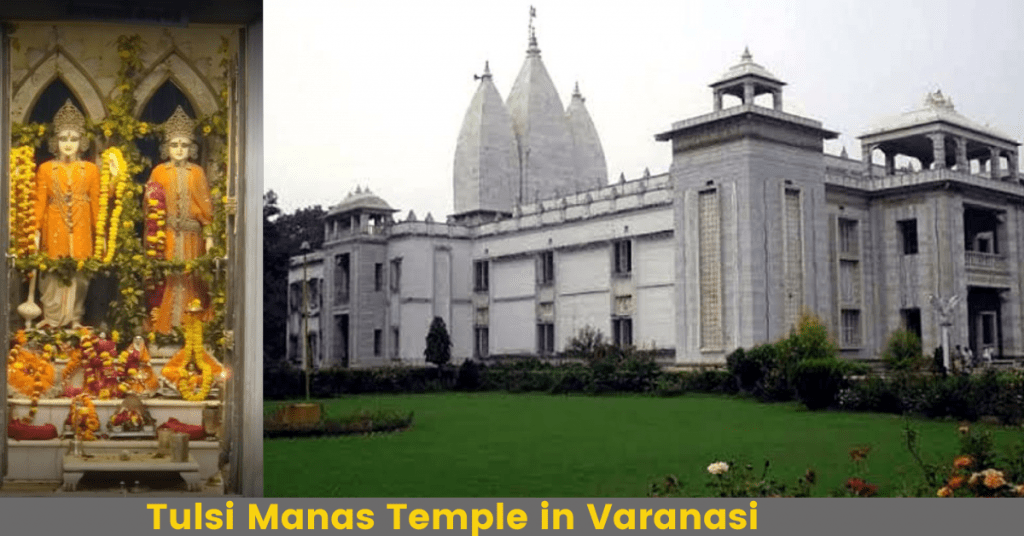Temples, Temples In Uttar Pradesh
Tulsi Manas Mandir in Varanasi: History & Significance,Temple Timings
Introduction: Tulsi Manas Mandir in Varanasi
Varanasi is a holy land on the banks of the Ganges. It is the oldest living city in the world. Often referred to as India’s cultural and religious capital, Varanasi is a land of temples, pilgrimage, and peace. In the old times, it was known as Kashi or Benaras but, it is now officially known as Varanasi. However, people still like to call it Benaras or Banaras. Varanasi has been attracting tourists and pilgrims for decades as a dwelling of history, culture, and religion. From the ancient tombs to ashrams, gleaming glamour of Ganga aarti, alluring alleys, Benarasi sarees, and magnificent temples, every bit of the city is a fascinating dream. One such glorious work of art and devotion is Tulsi Manas Mandir in Varanasi. It is named after a great 16th-century saint Tulsidas.
Tulsi Manas Temple, Varanasi is a holy shrine attributed to Lord Rama. It is at a distance of 1.5Kms from Banaras Hindu University. Constructed by the Sureka clan of Banaras, the temple is a site worth visiting for its historical significance and architectural beauty.
History & Beauty of Tulsi Manas Mandir
Tulsi Manas temple holds a very significant position in India’s religious and cultural history. The great saint Tulsidas translated Valmiki’s Ramayana into Hindi at this site in the 16th century. Tulsidas introduced Ramanaya to the masses with his famous epic Ramcharitamanasa (Lake of the deeds of Rama). Rama was presented as a great king to the public for several years. It is because of Ramcharitamanasa, that King Rama became Lord Rama, a Hindu deity.
Made with white marble, the temple stands tall in white, away from the city’s hustle. Each temple wall beautifully depicts various scenes from the Hindu epic, Ramanaya. The interior is adorned with the idols of Lord Rama, Sita, Lakshmana, & Hanuman. The temple’s walls are inscribed with different types of Chaupayees, Dohas, Chhandas, and Sorathas. The temple’s main gate has Shri Tulsi Manas Mandir Haridwar written on it. Tulsi Manas Mandir, Varanasi is surrounded by a lush green tulsi garden on the right of the entrance with a statue of Tulsidas which illustrates the stanza “Tulsi Das Chandan again; tilak gets Raghuvir. On the left of the temple entrance is a beautiful pond with four ghats.
Each bank of the ghat has different statutes of special subjects from the Hindu epic, Ramanaya. A statue of Shri Kakbhushundi stands on the north bank, Shri Yagywalkaji Maharaj on the south bank, and a statue of Shri Ashutosh Shankar and the Goswami Tulsidas Ji on the east and west ghat, respectively. The center of the temple has a Ram darbar with idols of Lord Shiva and Mata Parvati.
Other Attractions of Tulsi Manas Mandir
Besides pilgrimage, the temple also offers a learning opportunity for travelers. It houses a museum allowing travelers to gain an informative experience and learn more about the Hindu epic, Ramanaya. Over the years, the temple has attracted more and more pilgrims and visitors from the length and breadth of the country and beyond.
Tulsi Manas Mandir Varanasi Timings
The temple is open on all days, from Sunday to Saturday. However, the premises are open to the public from 5:30 am to 12:00 pm and 3:30 pm to 9:00 pm. They perform the aarti twice daily, one at 6:00 am and another at 4:00 pm.
Tulsi Manas Temple: Performances
During festivals, you will get a chance to immerse yourself in beautiful puppetry shows by local performers narrating tales from Ramcharitmanas.
Tulsi Manas Temple Location
One can locateTulsi Manas Temple in Varanasi @ Sankat Mochan Rd, Durgakund Rd, Near Jalan, Varanasi, 221005, India.
Temples Nearby
Other temples, such as the Sankat Mochan temple, Durga Mandir, and New Vishwanath temple, are close to this site.
In closing
We hope you enjoyed reading our blog on Tulsi Manas temple, a unique tourist attraction in Varanasi. It is a perfect site to capture a glimpse of Varanasi’s historical, cultural and religious essence. Do include this in your checklist when you plan a trip to Varanasi.

